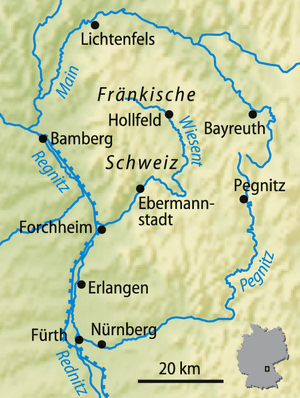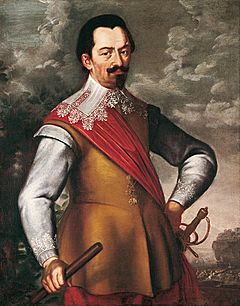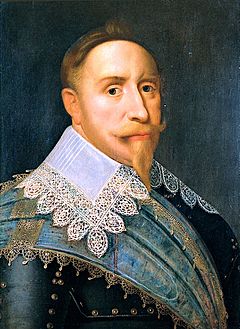Battle of Fürth facts for kids
Quick facts for kids Battle of Fürth |
|||||||
|---|---|---|---|---|---|---|---|
| Part of the Thirty Years' War | |||||||
 Map showing Regnitz river and Fürth: bottom left |
|||||||
|
|||||||
| Belligerents | |||||||
| Commanders and leaders | |||||||
| Casualties and losses | |||||||
| 1,000 dead 1,500 wounded or missing |
1,000 dead 1,500 wounded or missing |
||||||
The Battle of Fürth happened on September 3, 1632. It was a fight during the Thirty Years' War. This big war involved many European countries.
The battle was between the Catholic forces and the Protestant forces. The Catholic side was led by Holy Roman Emperor Ferdinand II. The Protestant side was led by King Gustavus II of Sweden.
The Catholic forces won a tactical victory. This allowed their army to move quickly into Saxony. The Swedish forces had to retreat.
Contents
What was Fürth like before the battle?
Fürth was a small market town. It had lost its market rights for a while. This meant it couldn't compete with nearby Nuremberg.
Nuremberg grew much bigger and richer. Fürth remained a small farming town. By 1600, only about 1,000 to 2,000 people lived there.
Fürth was important because of its location. It was near the Rednitz and Pegnitz rivers. These rivers join to form the Regnitz river.
A ford (a shallow place to cross a river) over the Regnitz made Fürth a key spot. It was an important way to get to Nuremberg.
Why was this battle important?
In the spring of 1632, King Gustavus Adolphus of Sweden had a big victory. He defeated the Catholic army at Rain. The Catholic army's leader, Count Tilly, died there.
After this, Gustavus Adolphus easily took the city of Augsburg. On May 17, he marched into Munich without any trouble. He then occupied Nuremberg and set up his army outside the city.
How did the armies prepare for battle?
King Gustavus Adolphus made a big mistake in August 1632. He marched on Fürth. His new opponent was General Albrecht von Wallenstein. Wallenstein had taken over the Catholic army.
Wallenstein quickly built a new army. He drove the Saxon army out of Bohemia. Then he moved towards Protestant-aligned Saxony.
Wallenstein set up his camp near Fürth. He built strong defensive earthworks. Gustavus had actually burned Fürth in June. Now he came back from the south. He took Nuremberg to stop Wallenstein's plans for Saxony.
Gustavus tested Wallenstein's defenses. This happened at the Battle of the Alte Veste in late August. The Catholic forces won a small victory. This forced the Protestant army into a defensive spot. Gustavus, who usually attacked, was now surrounded by Wallenstein's larger army.
The attack and its outcome
Gustavus finally got more soldiers on September 1. Then came the attack on September 3. Gustavus's forces tried to attack Wallenstein's well-protected army. But they lost about 2,500 soldiers.
Gustavus could not get Wallenstein to fight in an open field. Wallenstein kept his army in a strong defensive position. This plan worked. Gustavus's army started running out of food.
So, Gustavus had to pull his troops back on September 19. This created a stalemate between the two armies. The next big battle was the Battle of Lützen in November. The Protestants won that battle, but it cost them a lot of soldiers.
What happened after the battle?
The fighting around Nuremberg allowed the Catholic forces to move into Saxony. Fürth itself was almost completely destroyed by fire before the battle. It was mostly empty.
King Gustavus Adolphus died in the Battle of Lützen. That battle was very costly for both sides.
In the next few years, Wallenstein made some military mistakes. He also became very ambitious. The Emperor lost trust in him. Wallenstein was killed in 1634 with the Emperor's approval.



